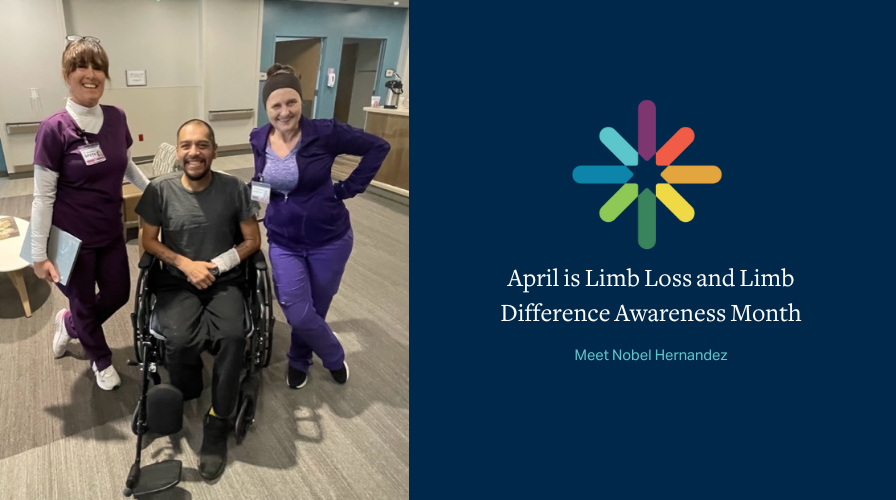
April is Limb Loss and Limb Difference Awareness Month and, this year, Reunion has joined the Amputee Coalition in its mission to “Inspire to Elevate,” by sharing a Reunion success story from a recent Reunion Phoenix patient, Nobel Hernandez. While more than 2.7 million people live with limb loss or limb difference in the United States, survivors of limb loss, such as Nobel, elevate their potential every day by inspiring those around them.
Meet Nobel
When Nobel Hernandez arrived at a Phoenix hospital in late February, doctors told him that they would need to amputate his right lower leg. Nobel had always been athletic and he described feeling depressed in the days leading up to and following his surgery. Patients who have recently undergone an amputation often describe similar experiences of depression, while others report symptoms of anxiety, PTSD, isolation, and diminished self-esteem. In addition to learning to cope with limb loss and changes in body image, these patients must manage post-op discomfort and work to improve mobility, balance, endurance, and strength, often in preparation for the use of a prosthetic.
As Nobel began to recover, he was often too distracted by his physical and emotional discomfort to consider the rehabilitative treatment options his hospital team recommended to him until one Reunion Rehab clinical liaison, Amy, visited his hospital room. Nobel was not interested in treatment right away, but day after day, Amy returned to his room to answer his questions and make the same promise to him over and over again: “We will give you the best treatment available.”
One month later, Nobel says, “She was not wrong.”
Within a few hours of checking in to Room 224 at his local Reunion Phoenix Hospital, the Reunion team evaluated his strength, mobility, balance, and physical endurance. The next day—medical charts and blood work in hand—they got to work. Many patients with an amputation assume their physical and occupational therapists will focus on mobility exercises, so Nobel was surprised when physical therapist Greta Swasey-Hadlock and occupational therapist Kim Briggs drove him to complete “full-body workouts” that were “much more than [he] expected.”
Initially, Greta started with hamstring curls and hip abductions to help him build strength in his left leg, but she gradually trained him to use parallel exercise bars so that he could practice gait training. In the meantime, Kim worked with Nobel on skin care, pain management, balance, and limb shaping (or the management of residual limb swelling via a compression sock).
While Kim and Greta were sure to give Nobel time for relaxation and recovery, he didn’t get a break from therapy on the weekend. As an inpatient rehabilitation hospital, Reunion provides patients fifteen hours of therapy per week, so on Saturdays, he worked with physical therapist Marghi Demer and occupational therapist MaryBeth Selby who helped him build on the training goals he’d accomplished during his weekdays. Over time, Nobel developed both physical and mental strength. The exercises were not only helping him manage his mood, they showed him that he was still capable of tremendous feats of athleticism.
After several weeks of hard work, the day of his Hanger prosthetic evaluation arrived. During every Hanger evaluation, prosthetic specialists work with patients, families, and their care teams to determine an individual’s current experience of mobility, their long-term mobility progress and trends, and their satisfaction and quality of life.
Nobel was extremely enthusiastic about the evaluation, once he realized he was on the verge of learning to walk again and regaining full independence. Currently, Nobel is hard at work with Kim, Greta, Margi, and MaryBeth and he has made incredible physical improvements each and every day. He has begun to “see and cook for [his] kids,” again and the time he spends with his family has motivated him to help patients who may be feeling isolated or depressed after an amputation. “Once I am walking again and, on my feet,” he says, “I want to help volunteer and motivate patients to reach their goals.”
The Reunion Phoenix team, meanwhile, is overjoyed with Nobel’s success as he prepares to return home to his family, and ultimately return to Reunion to support other patients preparing to return home to their families and communities.
Thank you, Nobel, for all your hard work! We look forward to seeing you again soon!
More Articles